Dolmens are historical burial tombs that are to be found in the rolling plains of Leinster and the rocky outcrops of the Burren and other hilly areas. Many of these sacred burial chambers are placed where the summer and winter solstice sunrises are most vivid.
Browshill Dolmen, Carlow 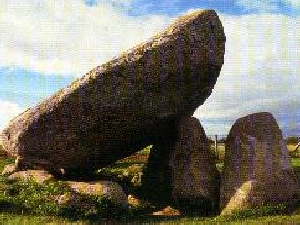
A field monument of huge proportions, the capstone is believed to be the largest in Europe. The location, setting and purpose of this Megalithic structure have been the subject of conjecture for centuries. Most likely it marks the burial place of a local king of long ago but has been invested with a rich overylay of myth and legend.
Access to the Dolmen is direct via carpark and enclosed pedestrian pathway. Please obey the country code.
Aughnacliffe, Longford 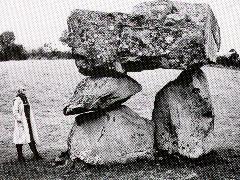
One of a small group of portal tombs which have two capstones 9 others include Knockeen in Waterford, Kilmogue in Kilkenny and the Kempe Stones in Down). Like many ‘dolmens’ it stands in a hollow, so that the visitor’s initial view of it is from above. The main capstone is 9 feet long and rests at the front on the single remaining portal stone, 6 feet high, on which a small Christian cross has been inscribed, apparently recently. The lower capstone is supported on the chamber uprights and, as it now stands, the whole presents an eye-catching study in balance.
Ballylumford Dolmen, Antrim 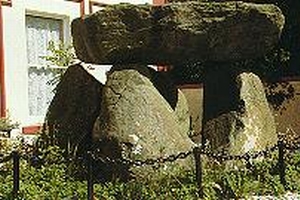
The Ballylumford Dolmen is better known to locals as the Druid’s Altar and is a dolmen typical of many found in Ulster and throughout Ireland. Larne used to be called “the port of the Standing Stones” by the Romans, no doubt because of the presence of dolmens like this one and the numberous standing stones and boundary marker stones which can still be seen across the borough. The dolmen, under which historical artifacts have been recovered by archaeologists, would appear to have stood over a burial chamber of ancient times. It is situated on the road between Mill Bay and Ballylumford.
Kilclooney Dolmen, Donegal 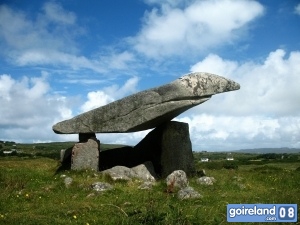
An exceptionally fine portal-tome or dolmen, prominent on the skyline 1/4 mile to the east of the main road, 4 miles north-north-west of Ardara. It well displays the classic features from which this type of monument derives its name. The matched portal stones and gracefully uptilted capstone (nearly 20 feet long and one of the largest in Ireland) oversailing the chamber entrance convey a sense of architectural awareness on the part of the builders and its streamlined profile has inspired numerous analogies; a bird, a fish, Concord, etc. depending on the imagination of the observer.
The tomb is substantially complete. A low sill-stone set between the 6 feet high portals closes off the chamber entrance. The lower end of the capstone does not rest directly on the back-stone as is usually the case, but is supported instead by a small intermediate stone whose function may have been to give increased height to the chamber. Fragments of undecorated Neolithic pottery were the only recorded finds. A short distance west of this tomb is another similar construction but on a very much smaller scale.
Woodtown, Dublin 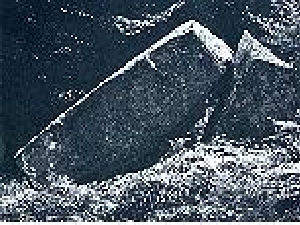
Although partly collapsed on its supports and overgrown with bracken and scrub, this is nonetheless a noble megalith.
when complete it would have stood 15 feet high at the chamber entrance, where there now survives only the broken portion of one of the great portal stones, against which the massy capstone leans, its other end resting on the ground. A second portal stone nearly 15 feet long, lies fallen alongside.
Borlase believed this to be a distinct class of tomb - an ‘earth-fast’ dolmen, so-called from the capstone’s contact with the ground at the back (another example being Howth dolmen in the same county). However, the term is not recognised in modern archaeology.
It is of course possible that the back of the capstone was never raised up; but, as we have seen in other large monuments, such feats were well within the capabilities of Neolithic tomb-builders.
Haroldstown Dolmen, Carlow 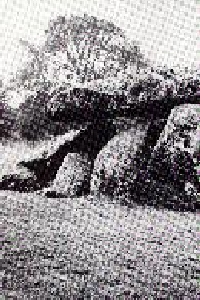
Improbable though it may seem, this interesting megalithic tomb was lived in by a family in the nineteenth century, a purpose to which its large interior was suited and possibly to some extent modified. Gaps between the side-stones were windproofed with turf and mud, and no doubt the resulting ‘house’ was as snug as some of the tiny cabins occupied around the time of the Great Famine. The presence of a horse in the photograph is a reminder too that these ancient structures not infrequently served as animal shelters in the past. A visitor to the group of chamber tombs at Farranmacbride in Co. Donegal in 1871 records; ‘On getting into another cavity, I found two black lambs inside, and in another some pigs, in another calves. The Haroldstown dolmen stands near the bank of the Derreen River at Acaun Bridge, 4 miles north-east of Tullow. The chamber, 13 feet long and nearly 9 feet wide at one point is more spacious than most portal-tombs and comprises about ten upright stones. There are two capstones, the larger of which measures some 12 feet in length.
Proleek Dolmen, Louth
A very fine example of a Portal Dolmen in the grounds of the Ballymascanlon Hotel, and with a capstone of about 40 tons supported by three legs. Legend says that a wish will be granted to those who can throw a pebble on to the top of the capstone so that it stays there. In the same field a wedge-tomb can be found.
Kilfeaghan Dolmen, Rostrevor, County Down
This dolmen has two portal stones supporting a massive granite capstone which is estimated to weigh about 35 tons. The tomb, built around 3000-2500 B.C., stands near the northern end of a long rectangular stone cairn. Excavations long ago apparently uncovered bone, Neolithic pottery and flint.
Kilfeaghan Dolmen is well sited on the southernmost slopes of the Mourne Mountains, half-way between Rostrevor and Kilkeel, and with a panoramic view offer Carlingford Lough.
